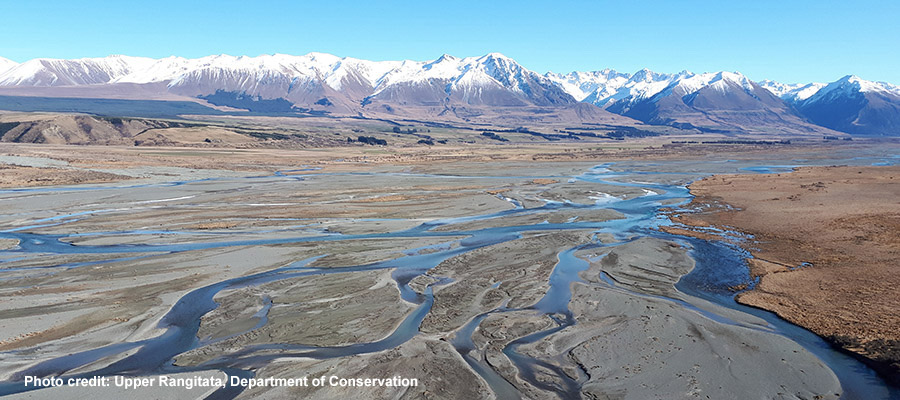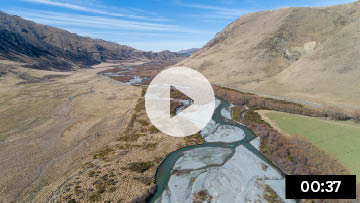
Braided rivers – what’s the story?
Our iconic braided rivers are unique in the world – only seen in a few other places – and are an integral part of the landscape that Cantabrians feel passionate about and want to look after.
Canterbury has the largest number of braided rivers in New Zealand. The seven alpine rivers that contribute 88 per cent of the flow within the region are all braided – namely, the Waiau Toa/Clarence, Waiau Uwha, Hurunui, Waimakariri, Rakaia, Rangitata and Waitaki Rivers.
Over time, and with historical use and development, the ecological and biodiversity values of these special rivers have deteriorated – our aim is to halt this deterioration and, where possible, reinstate these values.
Read on to learn why all the factors that make braided rivers unique – their multiple, shifting channels and banks, varying flows, variety of habitats, and ability to move over the landscape – also make it difficult to determine where a braided riverbed begins and ends.
Canterbury’s braided rivers are unique river ecosystems. They provide an outstanding habitat for many rare birds, fish, plants and other species.
The entire Canterbury Plain was formed by gravel carried from the Southern Alps by braided rivers. The movement of gravels, and working and reworking of sediments to form islands, plains, river mouths and coastal beaches, all contribute to sustaining the mauri (life force) of that braided river system.
A key part of their makeup is driven by their multiple, shifting channels, varying flows and shingle layers, and their ability to move over the landscape.
Photo credit: Black-fronted tern, Frances Schmechel
Biodiversity
The rivers are an abundant supply of food and support many species that can't be found anywhere else. Braided rivers provide feeding and nesting for approximately 25 species of native birds, with the majority classified as threatened and facing increased pressures as the natural character of these dynamic systems change.
As river protection organisation BRaid says: “The biologically rich braided rivers are one of the last remaining strongholds of biodiversity in the Canterbury Plains, forming a vital ecological link from the mountains to the sea.”
River margins have an important role in buffering aquatic ecosystems from effects of adjoining land use and provide habitat for indigenous flora and fauna in an otherwise highly modified landscape.
For more on biodiversity in rivers, and beyond, see “Our unique ecosystems”. To learn more about the birds of the Waimakariri, watch this video.
Cultural values
The practice of kaitiakitanga (guardianship) applies to the ecological health of all waterways. The Waitaki River, as the ancestral river of Ngāi Tahu, is of paramount importance.
Braided river-mouths in particular are culturally significant for Ngāi Tahu, provide an important habitat for many species, and are important for coastal gravel nourishment.
The Mahaananui Iwi Management Plan states: “Tangata whenua have a particular interest in the beds of lakes and rivers and their margins. River and lake beds and their margins may be significant for cultural use (eg, mahinga kai) or for the presence of significant sites (eg, wāhi tapu). […] For Ngāi Tahu, the beds and margins of lakes and rivers are part of the waterbody, and not separate from it.”
Recreation and tourism
They are also highly valuable for a wide range of recreational activities and an important tourist attraction. Fishing, boating and swimming are just some of the activities that people enjoy on the rivers. In addition, their beautiful appearance and iconic nature are a huge draw for tourists in the region.
For advice on how you can help our braided river ecosystems, DOC has this handy guide.


Because of their unique nature and significance for all Canterbury, we are firmly committed to protecting the region’s rivers and wetlands. We also have a clear legal responsibility to manage and protect them under the Resource Management Act (RMA). Riverbeds, in particular, are accorded high protection status under the RMA.
One thing to note is that Land Information New Zealand (LINZ), Department of Conservation (DOC) and regional councils (such as Environment Canterbury) are all responsible for different aspects of rivers.
Here are some of the ways in which Environment Canterbury helps to protect the rivers:
- The Canterbury Water Management Strategy (CWMS), being implemented by Environment Canterbury with community input, is responsible for looking after the region’s water and provides a collaborative framework to help manage the multiple demands on this precious resource.
- Environment Canterbury manages the lower reaches of most of the region’s major braided rivers to protect communities from flooding. Works range from construction and maintenance of stopbanks to vegetation management in active channels. Controlling vegetation enhances and protects habitat for vulnerable braided river birds.
- Working with DOC and other partners, Environment Canterbury carries out or facilitates a range of work in braided rivers specifically to protect bird habitat. Operations range from island creation to weed control and predator control.
- Through the provision and management of the Waimakariri and Ashley Rakahuri River Regional Parks, Environment Canterbury is able to provide a range of recreation services while also providing for protection and enhancement of biodiversity on plains sections of these two rivers.
- In 2015 Environment Canterbury released a report which showed that between 1990 and 2012, nearly 12,000 hectares of formerly undeveloped or forested river margin land in the region’s low plains was converted to intensive agricultural use - an average of about 530 hectares per year (more detail below).
- In 2017, following this report and with increasing public concern over land management change in braided rivers, Environment Canterbury convened BRAG (Braided River Action Group). BRAG brings together representatives from Environment Canterbury, Te Rūnanga o Ngāi Tahu, DOC, LINZ, Federated Farmers, Forest & Bird, and Canterbury’s territorial authorities. BRAG’s purpose is to:
- maintain the braided river character of Canterbury’s rivers in keeping with the CWMS;
- consider innovative and regulatory opportunities to improve land management; and
- prioritise and implement those changes consistently across the braided rivers.
- The Land & Water Regional Plan Change 4 (PC4) became operative in 2017. This strengthened the rules regarding the removal of vegetation from braided river beds and defined those beds to make it easier to understand how to comply with the stock exclusion rules.
- Environment Canterbury is currently working on the BRIDGE project, which it has established to work with stakeholders to clarify the extent of the “river bed” in braided rivers and how to manage their multiple values and margins (more detail below).
The 2015 report states: “These rivers must be allowed room to move back and forth over their braidplains, destroying and creating habitat as it goes. When braidplain extent is constrained or otherwise modified by agricultural encroachment or engineering works, natural character is reduced, with associated reduction of habitat diversity, habitat quality and biodiversity.”
It went on to recommend that “all further development within floodplains, river margins and active riverbed should go through full RMA consent process with conditions to avoid, remedy or mitigate adverse effects on significant indigenous vegetation and habitats of indigenous species, and the hydrology, ecology and natural character of braided riverbeds”.
For more info, this Stuff article from February 2017 gives a useful overview: “Over the line: Rivers being whittled away”.
Find out more about activities in and around braided riverbeds.
Consent advice in light of Dewhirst appeal
UPDATE 29 October 2019
The process of clarifying the rules on braided river beds in order to protect their natural character, ecosystem health and biodiversity values has recently been progressed. This process aims to provide clarity for landowners, planners and communities about what is and is not appropriate in braided river environments.
Part of this is ensuring a clear understanding of how to apply the legal definition of “riverbed” (under the Resource Management Act) to a braided river.
The Court of Appeal recently upheld a High Court decision on this matter.
The Resource Management Act (RMA) definition is “the space of land which the waters of the river cover at its fullest flow without overtopping its banks”. In our braided rivers, which do not have clearly defined banks, the definition is difficult to apply.
Environment Canterbury encourages anyone considering works that may be in the bed of a waterway to discuss them with us before undertaking any work to ensure full understanding of the potential issues. This should help avoid any disputes over whether they are working in a riverbed or not.
It can be confusing in terms of what can, and cannot, be done in and adjacent to our braided rivers, particularly given everyone’s duty under the RMA to avoid causing adverse effects on the environment.
Any changes in land use, including intensification of farming activities, installation of structures, or vegetation clearance, should always be undertaken cautiously.
If you are thinking of undertaking works in or near a braided river, we encourage you to approach us before you start. This will help identify sensitive environmental issues, apply the the definition of riverbeds and enable to you to work out which resource consents you may need.
UPDATE 18 February 2019
Environment Canterbury is engaged in a process of clarifying the rules on braided river beds in order to protect their natural character, ecosystem health and biodiversity values. This process is aimed at providing clarity for landowners, planners and communities about what is and is not appropriate in braided river environments. Part of this is ensuring a clear understanding for all parties of how to apply the legal definition of riverbed (under the Resource Management Act) to a braided river. This is why Environment Canterbury has appealed a recent High Court decision on this matter to the Court of Appeal.
We are aware it can be confusing on what can, and cannot, be done in and adjacent to our braided rivers, particularly given everyone’s duty under the Resource Management Act to avoid causing adverse effects on the environment. Any changes in land use, including intensification of farming activities, installation of structures, or vegetation clearance, should still be undertaken cautiously as if the Court of Appeal overturns the High Court decision, then retrospective consent may be required (and may or may not be granted).




